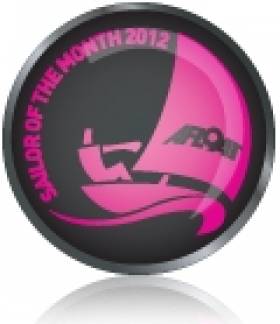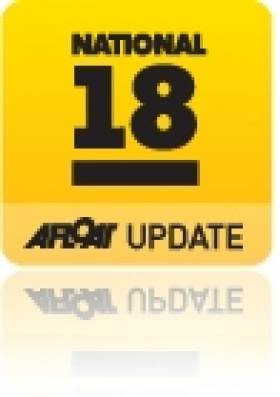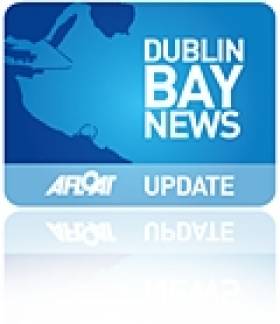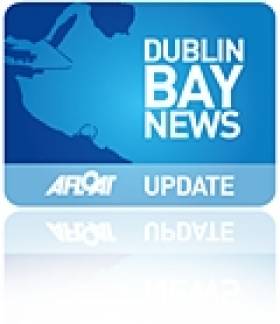Displaying items by tag: National Yacht Club
Olympic Race Officer Jack Roy To Give Talk at Howth YC
#HYC - Next week Howth Yacht Club will host international race officer Jack Roy of the National Yacht Club, who will give an illustrated talk on his experiences in Weymouth at the London Olympics last summer.
Roy was selected by the ISAF as a technical officer, one of only seven race officers selected to supervise the UK race management teams at the Olympics.
He was also the only one of the seven who rotated through all the courses, and his talk gives a fascinating insight on how the Olympic regatta was managed.
Roy's talk takes place at the HYC on Wednesday 13 March at 8pm, and will last about 75 mins with time for questions afterwards. Admission is free, but a voluntary donation to the RNLI is expected (€5 suggested).
Annalise Murphy is Irish Sailor of the Year for 2012
#sailoroftheyear - You followed her impressive exploits right here on Afloat.ie throughout the year, and your votes counted. So it's only right that our Olympic sailing hero Annalise Murphy should receive the honour of being named Afloat.ie Sailor of the Year for 2012.
The young sailor was recognised for a remarkable 12 months of incredible achievement, capped off by her stirring performance at the London Olympics - and topped a shortlist that featured fellow Olympic challengers Peter O'Leary and David Burrows, and such up-and-coming talents as Sophie Browne, Finn Lynch and Fionn Lyden.
Murphy's simply outstanding fourth-place finish in the Laser Radial at the London Games was Ireland's best Olympic result in 30 years in any class. Despite the heartbreak of so narrowly missing out on Olympic bronze in the medal race, her accomplishment was appreciated far beyond the Irish sailing community, and raised the profile of the sport in Ireland immeasurably.
The then 22-year-old, who sails for the National Yacht Club in Dun Laoghaire, had the entire country on edge last August as she battled with what Afloat's own WM Nixon described as the "fierce challenge" of being top of the Women's Laser Radial class, in stature as well as performance.
At 6ft 1in, the woman they call 'The Irish Lever' was undoubtedly the tallest in her 41-boat fleet at London 2012, and some British yachting pundits were quick to put down her early regatta wins purely to her larger frame.
But Murphy - who headed to the Olympics with confidence after a podium finish at the Skandia Sail for Gold, and a medal at Weymouth the previous year - proved that her success was no fluke, holding the gold medal position for almost half the regatta and entering the last race in third place overall.
Facing unbelievable pressure as the regatta reached its final stages on the Nothe course in Weymouth, in tricky conditions that would spread wide the times of most club racers, it's to Murphy's estimable credit that she was able to keep so tight with the front-runners, and it was only in the last few seconds - and last few metres - that she was knocked out of the bronze position.
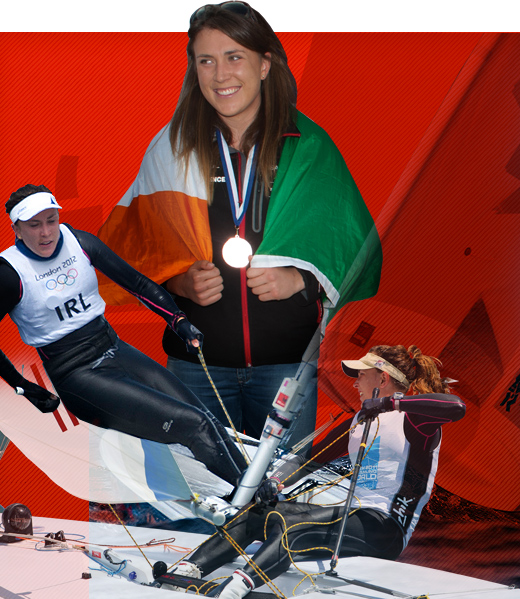
We'll never forget the tears she shed after the medal race's conclusion - the whole of Ireland shared in her heartbreak. But we also shared the belief that that was but one setback in a world-class sailing career that's only just beginning.
Considering the talented and dedicated NYC sailor and UCD student is still only 23, there's clearly plenty of sailing success awaiting in her future, and she starts 2013 on her 'Road to Rio' aiming to clinch a medal at the 2016 Olympic Games.
In spite of losing out on a podium finish at the ISAF Sailing World Cup in Miami earlier this month, the fact that she came so close - and led the charge in the early stages - proves that she can stand proudly with the elite in her class. And she'll have another chance to prove herself in the next round of the ISAF World Cup in Palma de Mallorca on 30 March.
The Sailor of the Year honour is the very least the amazing Annalise Murphy deserves for doing Ireland so proud in 2012.
Irish Yachtsmen Rescued From Stricken Vessel Off Bermuda
#Wolfhound - Four Irish yachtsmen have been rescued from a recently purchased vessel some 70–miles north of Bermuda after it suffered both power and engine failures amid stormy conditions off the northeastern United States.
The 48-foot Swan class sloop Wolfhound, purchased recently by owner/skipper Dalkeyman Alan McGettigan, had departed from Connecticut on 2 February en route to Antigua in the West Indies to compete in the RORC Caribbean 600.
As WM Nixon wrote on Afloat.ie recently, the Wolfhound was expected to eventually call Dun Laoghaire home following its Caribbean adventure.
But according to Bermuda's Bernews website, trouble began when the vessel reportedly suffered a loss of battery power due to the failure of a new inverter charger some 400 miles off the Delaware coast.
This was followed by engine failure a day after departure which left the vessel without communications or navigation systems for eight days.
Between Friday and Saturday the boat reportedly suffered two knockdowns in treacherous weather on the heels of the midwinter storm that recently battered America's northeastern states, and which led McGettigan to activate the on-board emergency beacon.
After a fruitless search by US Coast Guard aircraft, the yachtsmen were eventually located by and transferred to a passing cargo ship, Tetien Trader, which had joined the search effort.
The Wolfhound later sank some 64 miles north of Bermuda.
McGettigan's crew from the Royal Irish Yacht Club in Dun Laoghaire have been confirmed by the club's sailing manager Mark McGibney as Declan Hayes and Morgan Crowe.
Tom Mulligan of the National Yacht Club has been named locally as the fourth crew man on board.
A source close to Afloat.ie says that Hayes telephoned home from the Tetien Trader and confirmed he and the others were being "well looked after" by the Greek crew of the cargo vessel, which is due to land in Gibraltar on 19 February.
A member of the RIYC, Alan McGettigan is an experienced offshore skipper, previously sailing in areas as far afield as the Baltic Sea, the Caribbean, the South China Sea and the Mediterranean, and having competed in past Round Ireland and Dun Laoghaire to Dingle (D2D) races, most recently in the yacht Pride of Dalkey Fuji.
Dublin to Host Top Cork Dinghy Championships
#national18 – The National Yacht Club in Dun Laoghaire will be hosting the National 18 Irish dinghy sailing Championships, the first time since the mid 1960's that this exciting trapeze class will hold their Championships in Dublin.
The event will be held at the NYC from 15th & 16th June 2013.
The traditional stronghold for 18 sailing is based in Crosshaven and Monkstown in Cork where an active fleet of over 30 boats enjoys close racing on a weekly basis. They are a 3 person boat with essentially a one design GRP hull shape, with a large sail area flown on a carbon rig with one crew member using a trapeze.
They have an exhilarating performance being quicker than a Dragon upwind with gobsmacking speed downwind in any sort of a breeze. The fleet is peppered with quality sailors including former and current Olympians. Racing is lively, close and ferocious with the boats all matched with similar speed.
The hosts confidently expect a fleet of 25 boats to participate, augmented with entries also attending from some of the hotspots for 18 sailing in the UK. The fleet will have a division for Classic 18s, some of which are well over 60 years old and beautifully restored with their original clinker planking and wooden masts.
The photo of Fingal 226 below is of one of the famous rule bending so called "sticky" Parker (The famous UK builder of world beating 505s) built plywood boats constructed for Jack Flannagan of Skerries in the 1960's when the event was last held in Dublin.
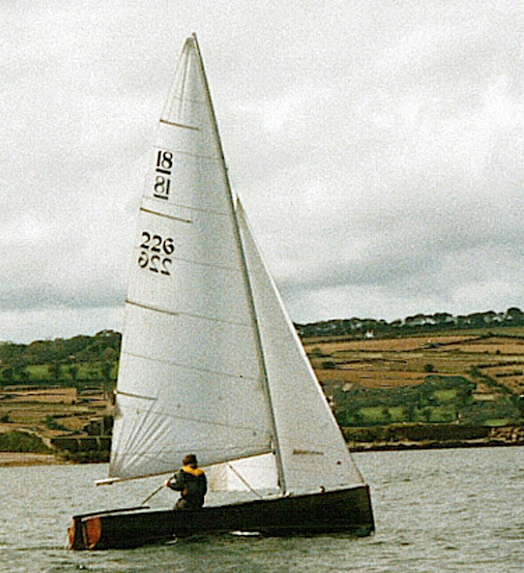
Both this boat and Finola 227 a sister ship built for Jack's brother, the famous Leo Flannigan, have been restored by enthusiastic owners to brand new condition and are still actively sailing in their original 1960's configuration. These outstanding boats being built of glued plywood planking, completely eclipsed the then commonplace traditional spruce planked boats and ultimately led to the adoption of the Proctor designed GRP smooth hull, which is still used today.
ISORA agm to Agree 2013 Offshore Race Programme for the Irish Sea
#isora – ISORA has issued its 2012 AGM Agenda plus its 2013 draft Race Schedule for the Irish Sea next year. Both are available for download below as pdf documents.
The race programme will be approved on November 17th at the National Yacht Club. Unfortunately the date clashes with the one day Irish Cruiser Racer Conference (ICRA) in Kilkenny where offshore supremo Damian Foxall will give a presentation.
The ISORA agm is followed by the Annual ISORA Prize Giving Dinner at the NYC where some of the most elegant sailing trophies including the Wolf's Head Trophy will be presented.
Irish Laser Sailors Earn International Success as Home Fleet Grows
#lasersailing – With news that Finn Lynch has added a European youth title to his ISAF Youth Silver medal Irish Laser sailing is on a high with international results coming at Olympic and youth level and for the domestic scene it looks like Howth's venerable winter league is returning to some sizeable fleet numbers as the Laser emerges as the ideal recession beating boat.
Lynch is the current U17 European Champion in the Laser Radial following a great regatta in Nieuwpoort, Belgium. It ends a fantastic season for the National Yacht Club sailor.
The superb result was followed when clubmate Philip Doran won the Europa Cup Regatta U19 category on Lake Balaton in Hungary earlier in September. Doran was second overall in the international event finishing on equal points with the winner.
Howth Laser Frostbite
Among a number of top dinghy sailors are moving to the Laser dinghy next month for the Howth Yacht Club's Laser Frostbites starting on November 4th.
The low maintenance single hander is proving to be a great recession boat and making a comeback at club level on both sides of Dublin Bay with DBSC's own handicap fleet dominated by the Olympic boat.
Up to 50 Lasers are expected for the frostbite series at Howth in a few weeks time. There's a handy format of two short races each Sunday with a first gun at 10:45 am.
There's a wide range of standards entering from high ranked national level sailors to beginners. The club is reporting strong interest to the extent
it may yet end up at 1990 levels where the long running series attracted up to 80, making it the biggest laser club racing series in the world at the time.
Laser Radial Programme
With an emphasis on preparation for overseas competition a Munster and Leinster Laser Radial Academy squad has been announced along with training dates for Autumn 2012 starting this weekend. The full squads named are below.
MUNSTER
Mark Hassett
Darragh O'Sullivan
Daire Cournane
Dara O'Shea
Tadhg O'Loingsigh
Darragh McCormack
Sorcha Ni Shuilleabhain
Darragh O'Sullivan
Conor Murphy
Dermot Lyden
Aisling Keller
Ross O'Sullivan
LEINSTER
Dan O'Beirne
Rory McStay
Kevin Harrington
Cian Cahill
Patrick Cahill
Luke Murphy
Aoife Hopkins
Stephen Craig
Frank Devlin
Ronan Jones
London Visitor Takes Flying fifteen East Coast Title
#flying fifteen – London helmsman Charles Apthorp crewed by Dublin Bay local Alan Green picked up the Flying Fifteen East coast championship at the National Yacht Club in Dun Laoghaire today.
Second were Ben & Mary Jane Mulligan from the host club with Strangford Lough's Brian McKee & Steve Martin third.
The end of season event that so often succumbs to October gales was reduced again but this year due to lack of wind on Dublin Bay. London Olympic race officer Jack Roy and his team got three races in on Saturday but regretfully there was no racing today.

At the Flying fifteen East Coast championships today hosted by the National Yacht Club were (left to right) Peter Murphy Class Captain, Alan Green with East Coast trophy and visiting helm Charles Apthorp. Photo: Ronan Beirne
A 28 boat fleet sailed for prizes in Gold, Silver, (Niall Meagher & Nicki Matthews) bronze (Frazer Mitchell & Gabriel Grier) & classic fleets (Adrian Cooper & Joe Corrigan).
Full results are available to download below as a jpeg file.
Dun Laoghaire Says Farewell to the MOD70s
#mod70–Dun Laoghaire, Ireland bid a brisk, breezy farewell to the MOD70 European Tour fleet with Sébastien Josse's crew on Groupe Edmond de Rothschild collecting the maximum 3 bonus points from the prologue circuit and leading the fleet out on to Dublin Bay for the leg to Cascais, Portugal.
In a brisk 15 knot SW'ly breeze the preliminary circuit of two triangles delivered great entertainment for the big crowd of spectators and challenging racing for the teams. Josse's crew lead Spindrift racing – the winners of the Dun Laoghaire City Races with Race for Water taking 1 point for third.
Dun Laoghaire, Ireland bid a brisk, breezy farewell to the MOD70 European Tour fleet with Sébastien Josse's crew on Groupe Edmond de Rothschild collecting the maximum 3 bonus points from the prologue circuit and leading the fleet out on to Dublin Bay for the leg to Cascais, Portugal.
In a brisk 15 knot SW'ly breeze the preliminary circuit of two triangles delivered great entertainment for the big crowd of spectators and challenging racing for the teams. Josse's crew lead Spindrift racing – the winners of the Dun Laoghaire City Races – through the scoring gate, with Race for Water taking 1 point for third.
Once more it is was Spindrift racing who made the best start but Groupe Edmond de Rothschild were better positioned for the first gust and they were able to accelerate ahead of Spindrift racing.
It was not the start that the MOD70 European Tour leaders FONCIA wanted.
They were slow off the start line and then fouled Musandam-Oman Sail at the outermost mark on the second round and had to take a 270 degrees penalty turn. Along with a temporary problem with a winch, FONCIA already had their work cut out when they left Dun Laoghaire in fifth place.
The skies remained clear with some sunshine for the send off after two days of great City Races, but the weather outlook promises a tough tactical beat in a building SW'ly wind round to the Fastnet rock.
The 200 mile leg round to the lonely light, known as Ireland's teardrop as it was the last landmark that Irish emigrants saw as they set off for America in the 19th century, will not only see robust, potentially boat breaking seas but may offer an early split in the fleet depending on the timing of a cold front which is due there at around the same time as the fleet.
Teams will be working at maximum effort to gain every metre, expecting to pass Fastnet in the early hours of Monday morning, the first section of the 1218 miles course. Thereafter it will be a fast, almost direct reach towards Cape Finisterre. The leaders are expected to reach Cascais on Wednesday morning.
"This is an important leg for us to hold on to our lead over our rivals." Warned Michel Desjoyeaux, skipper of FONCIA, "the downside of being in the lead that you have people who want to knock you off, but then there is also the extra confidence which comes with being in the lead with a points cushion.
The route to Cascais is not direct and there will be a balance between the wind strength and the conditions to deal with. It is going to be complex and with it is likely that we will not be on a direct route."
Quotes:
Michel Desjoeyaux (FRA), skipper FONCIA (FRA):
"There will be some subtleties on the weather side of things to work on with stronger breeze one side and then options of a more direct course on the other. The routings show one thing but then on the actual race there are subtleties and local effects that you have to take into account and know how to read and work with. This is actually good because it is pretty much the only leg where we have offshore racing so on an open ocean race course after the Fastnet.
We are going to have to be fast but also choose the right way across. So we are in ocean racing mode with interesting conditions on a really very strategic leg, probably the most open of the MOD70 European Tour."
Sidney Gavignet, FRA, skipper Musandam-Oman Sail (OMA)
"The conditions will not be as tough as initially expected but there will be a few key moments I think. One as we leave Ireland where the wind is due to ease a bit so will have to not stay too close to shore and then the second one is roughly just at the Fastnet Rock when it will be important to not get stuck behind the front and then keep out west and not get tempted by following the more direct course. Another key moment could be the finish with little wind."
Yann Guichard, FRA, skipper Spindrift racing:
"It is going to be a key leg because it will mark the mid point on the MOD70 European Tour and we have to try and claw back some of the gain FONCIA has on us. There are going to be a number of stumbling blocks on the leg and a key point of passage after Fastnet, which we have to leave to port. It is not very clear just after that and we will have to really be careful to negotiate the finish well. It is going to be a nice gull wing shape route. Like the first leg, we could see light conditions for the finish."
Sébastien Josse, FRA, skipper Groupe Edmond de Rothschild (FRA):
"This is a traditional offshore ocean race leg with a weather forecast that is easier to work with, and with fewer oil platforms, course marks and so on to deal with. The first night is going to be pretty tough with some 15 upwind tacks to do to get to the Fasnet Rock before we head out and south to the nice weather! The key moments on this leg will be the passage at Fastnet Rock when we have the cold front coming over us that will give the favourable downwind conditions and provide the first with the chance of extending the gaps."
Steve Ravussin, FRA, skipper Race for Water (SUI):
"It is a Franck Cammas Volvo leg! There will be some interesting moments with the various fronts to deal with and strategical decisions to be made, but then Franck is good at that kind of thing. We are going to have to be both fast on the helm and good on the strategy.
Upwind, then some tough changes to negotiate to and at the Fastnet, but the boat is good for these conditions, then we have the better downwind weather for the finish in Cascais. I think it is going to be a nice race and we have to put the pressure on after the first leg, but then I feel good about this leg. We have some good helmsmen on board with Franck and my brother (Yvan Ravussin) and are going to work on smooth manoeuvers and maintain close contact with the fleet."
Giant Trimaran Fleet Arrive in Dun Laoghaire
#mod70 – Like giant exotic creatures from another planet the MOD70 Trimaran fleet arrived in Dun Laoghaire overnight after their first leg from Kiel in Germany. With one colourful hull suspended in air even early morning joggers on Dun Laoghaire's East Pier stopped to view the new arrivals into the Carlisle basin. Sails down and safely berthed near the town bandstand the five boat fleet there is no sign of life on board this morning as the 70-foot long craft dwarf all locally based craft at the National Yacht Club, adding a touch of Autumn glamour to the East coast port.
After around 1400 miles and three and a half days of hard racing from Kiel to Dun Laoghaire, Ireland just 77 seconds finally separated the top three MOD70 one design trimarans when the MOD70 European Tour leaders broke the finish line in a dying breeze just after midnight on Dublin Bay.
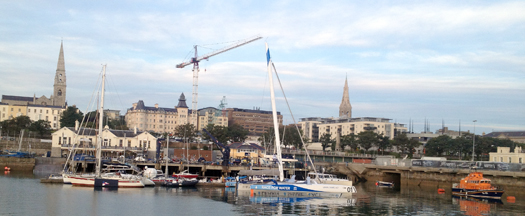
Four of the Trimarans are along side the Carlisle pier and one is berthed on the National Yacht Club pontoon
It was a heart-stopping conclusion to the first of the five offshore legs which takes the fleet from Germany to Genoa, Italy with stops in Dublin, Cascais and Marseille. Michel Desjoyaux's crew of FONCIA had only seized the lead from long-time pacemakers Spindrift racing within the final 15 miles of the finish.
But within 50 metres of the finish line in the fickle, patchy breeze they had slowed to a crawling two knots.
They only just squeezed across the finish line, 31 seconds ahead of Yann Guichard's Spindrift racing which in turn only just held off Sébastien Josse's hard driving young crew on Groupe Edmond de Rothschild who missed out on second by only 46 seconds.
"It was tough the whole time." Commented double Vendée Globe winner Desjoyeaux, skipper of FONCIA" We kept in contact with Spindrift in particular most of the time and then Groupe Edmond de Rothschild seemed to be the biggest threat, but we just never gave up and it paid off on the finish. We played all the little wind shifts and our sail trimming to get ahead and had to constantly trim and adapt to the conditions to get ahead of Spindrift racing."
For Desjoyeaux's crew there was the satisfaction of adding to their Betfair City Race series points win in Kiel, whilst for the Guichard team there was the disappointment at losing out on a leg which they lead for most of the 1238miles distance, through the full range of conditions. But, equally, Guichard reflected that the finish was so close that they might as easily have finished third. And for Josse and his Groupe Edmond de Rothschild team there is the considerable satisfaction of having put together an accomplished performance that came so close to winning.
In fact it was a fitting climax to an engaging first leg which has offered the five strong fleet of MOD70 trimarans a good share of each type of wind conditions, from a robust beat around the Skagen point on the tip of Denmark, a tactical light winds beat in the North Sea, through a high speed plunge down the Channel to Land's End, averaging close to 30kts for a sustained period, and finally a 200 mile beat up the Celtic Sea to the nerve shredding finish.
Though FONCIA lead out of Kiel last Sunday night, Spindrift racing took the lead on the W coast of Denmark on the speedy descent to the North Sea. And from there until the final miles they had looked like the team most likely to win.
In contrast Stève Ravussin's crew on fourth placed Race for Water started only modestly, finishing their Monday morning with a deficit of some 70 miles or so on the leaders. But they worked hard to come back and in the end they were just over 34 minutes behind the winner. Spindrift racing had FONCIA within sight for most of the race and it turn Groupe Edmond de Rothschild were close to the FONCIA since the Channel.
Sidney Gavignet and his crew of Musandam-Oman Sail were unfortunate to lose the breeze as it shut down. Finishing fifth they had been duelling for the entire course with Race for Water, which counts with Volvo Ocean Race winner Franck Cammas and Thomas Coville on board.
MOD70 European Tour, Leg 1 Kiel to Dun Laoghaire, 1238 miles (times inGMT)
1-Michel Desjoyeaux (FONCIA) 23h 19 '09 Sept. 5 in 3d 10h 49' 09
2-Yann Guichard (Spindrift racing) at 23h 19 '40 in 3d 10h 49' 40 (+31secs)
3-Sébastien Josse (Groupe Edmond de Rothschild) at 23h 20 '26 in 3d 10h 50' 26 (1min 17secs)
4-Steve Ravussin (Race for Water) at 23h 54 '25 in 3d 11h 24' 25 (+35min 16sec)
5-Sidney Gavignet (Musandam, Oman Sail) at 00h 54 '00 Sept. 6 in 3d 12h 24' 00 (1h 34m 51sec
MOD 70 Fleet Just 500 Miles from Dun Laoghaire But Facing Light Headwinds
The leader of the MOD 70s is 500 miles from Dun Laoghaire after passing the half way point on the 1238 miles stage from Kiel to Dublin this afternoon. The five boat fleet remains very closely matched, all making very similar speeds – around 10-12 knots of boat speed.
As they close the final 50 or so miles to the bottleneck that is formed by the Strait of Dover, the busiest shipping lanes in the world, the 70 foot trimaran fleet on Leg 1 of the MOD70 European Tour has continued to move well considering they have headwinds of less than 10 knots, but they will likely slow down even more before they can escape the worst of the small high pressure cell which is effectively guarding the entrance to the English Channel.
After passing the half way point on the 1238 miles stage from Kiel to Dublin, the fleet remains very closely matched, all making very similar speeds – around 10-12 knots of boat speed.
Winds may be light but the pressure remains very intense on this second full afternoon at sea. Knowing that whichever crew can break through the barrier of light winds first and escape into the channel might gain the decisive advantage. Once through the light winds zone the leaders will break into a progressively building breeze from the N'ly quadrant. Accelerating faster and faster, with the prospect of completing the Dover to Land's End passage in some 12-14 hours, the key tactic this Tuesday afternoon is not to be left behind in the Strait.
Brian Thompson from Musandam-Oman Sail reported this morning: "Everyone is concentrating on getting the best speed out of the boat, and we can see that today is a critical day as the wind is going to fall sharply near the Thames Estuary and the fleet is likely to compress. Who gets out of the light patch first may have a lead till approaching Ireland.".
And the fleet remains very closely matched: "We saw Groupe Edmond de Rothschild in the morning yesterday; and although we went entirely different routes all day, and were up to 50 miles apart, we saw them again in the evening! This morning we can see them about 6 miles away - exciting racing." Continued Thompson.
Seeking a chance of additional thermal sea-breeze activity closer to the coast is one possible strategy, but conversely those erring too close to the high land may also lose out when the breeze blows from the forecasted more offshore direction.
Spindrift racing, the leaders since the first night of racing, continued to hold a delta of about five miles on second place, but Sebastien Josse's Groupe Edmond de Rothschild has made a good inroad into FONCIA during the late morning and afternoon and were less than half a mile behind Michel Desjoyeaux's crew.
Having proven a thorn in the side for the FONCIA crew in last month's KRYS OCEAN RACE, it will have been a source of some bemusement to again see Groupe Edmond de Rothschild's dark blue pattern sails looming ever larger from the horizon today.
Guichard and crew on Spindrift racing have split closer to the English coast mid afternoon, diverging temporarily away from the second and third placed MOD70's engaged in a Pas de Deux in the final reaches of the Pas du Calais. But with just 23 miles between first and fifth placed Race for Water, the fleet remains tightly grouped.
Ravussin's Race for Water struggled with an electronics problem, which has meant they were initially unable to get and use high-resolution weather information. This compounded their initial errors, struggling with a bad sail change during the first late evening. But from being more than 70 miles behind, Ravussin, Cammas, Coville and Co have kept chipping away and are now very much in touch with the leaders and passed Musandam-Oman Sail to steal fourth. "We have sailed less than our rivals and so it does not come so easily, but we are getting there." Reassured Ravussin when contacted at midday.
Standings at 12h45 UTC 4th September
1- Spindrift racing (Yann Guichard) at 504,4 miles from Dun Laoghaire
2- FONCIA (Michel Desjoyeaux) at 7,1 miles from leader
3- Groupe Edmond de Rothschild (Sébastien Josse) at 7,4 miles from leader
4- Race for Water (Stève Ravussin) at 14,1 miles from leader
5- Musandam-Oman Sail (Sidney Gavignet) à 16 miles du leader



























